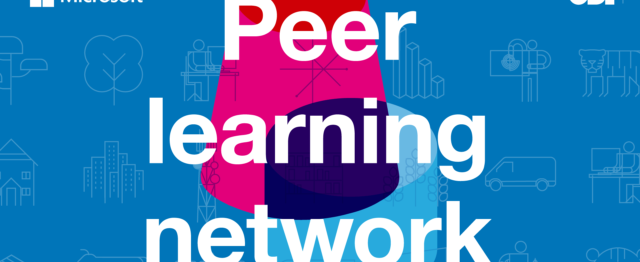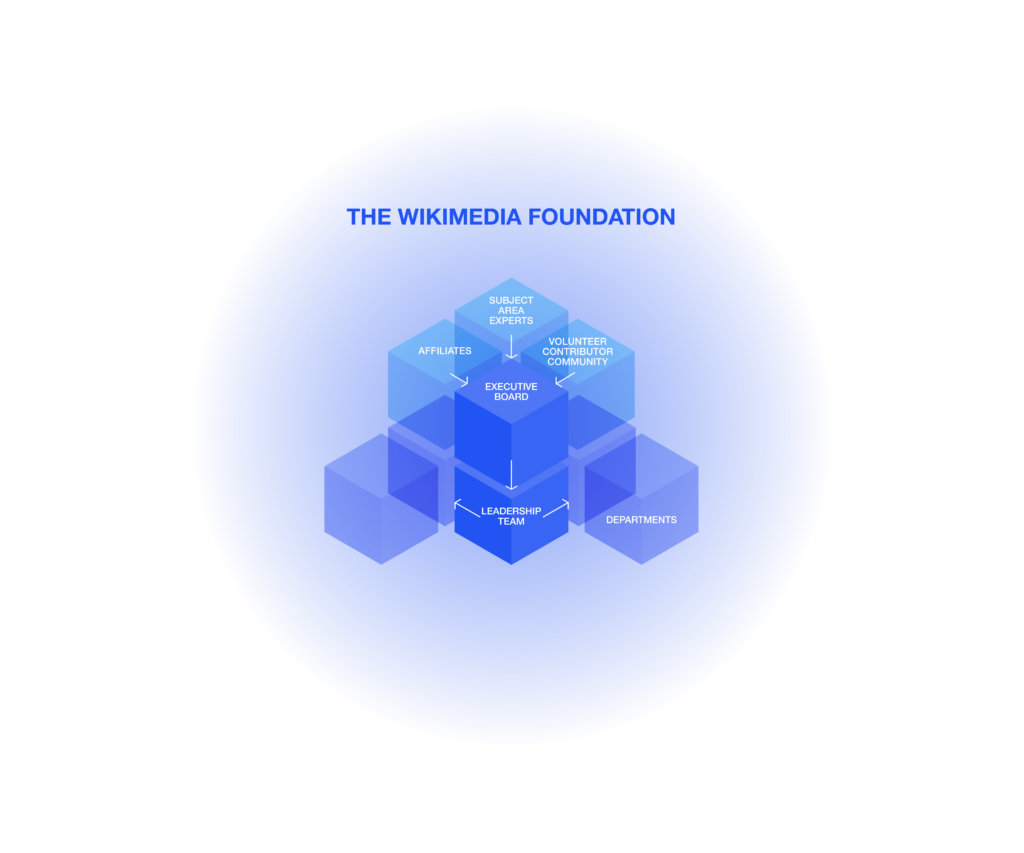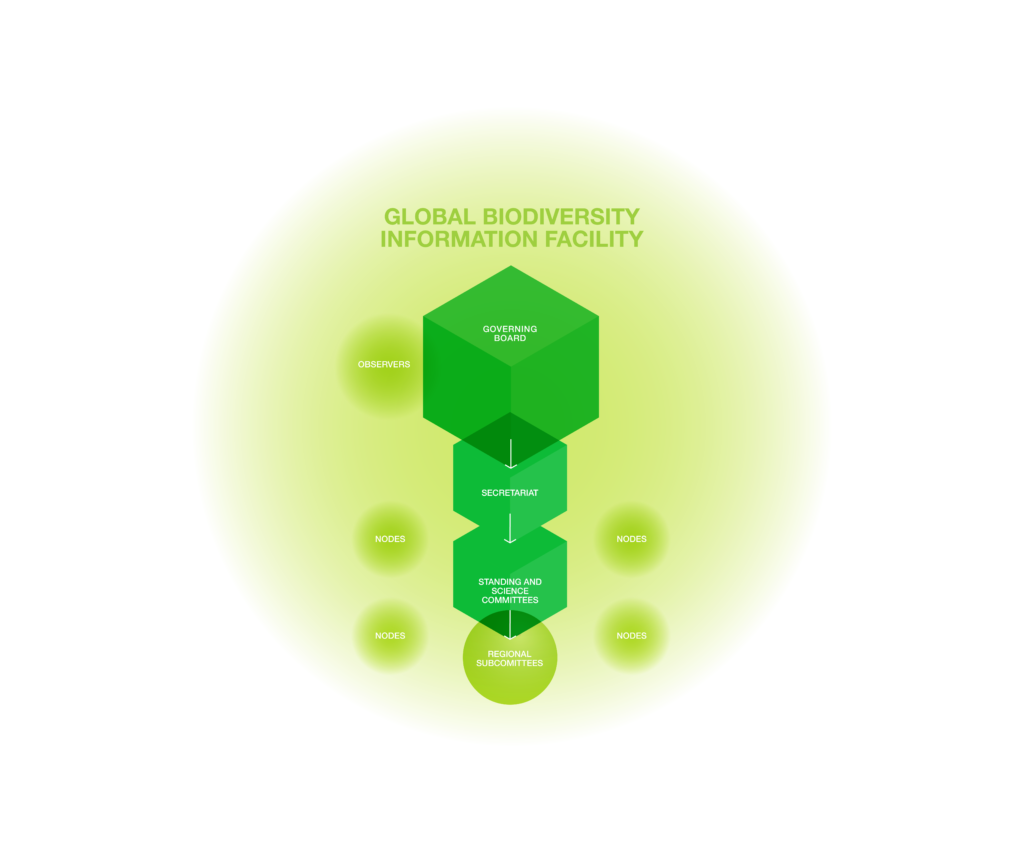
We’ve been convening organisations that steward open data as part of our second peer-learning network with Microsoft. As part of the peer-learning network, we recently held a roundtable discussion focusing on how the right governance model can help open data stewards to fulfil their mission. In this blogpost, we share reflections from the roundtable alongside some illustrations which visualise how some of these organisations are structured.
Organisational governance for open data stewards
For any mission driven organisation, it is critical that the organisation’s governance model supports effective decision making, so that the organisation can deliver their intended impact. In a recent roundtable with the peer-learning network members, we unpicked what good organisational governance looks like for open organisations, with a focus on leadership structures, team structures and resource allocation. The primary contributors for this session were the Wikimedia Foundation, the OpenStreetMap Foundation and the Global Biodiversity Information Facility (GBIF).
This blogpost summarises what we learnt from each of these organisations and attempts to capture key aspects of each organisation’s governance structure in a clear, visual diagram.
The Wikimedia Foundation (Wikimedia)

The Wikimedia Foundation is a non-profit organisation which is registered as a foundation under US law. The foundation was initially set up as a means to fund Wikipedia and other Wikimedia projects.
Leadership structure
The foundation is overseen by a Board of Trustees, which is ultimately accountable for the foundation’s work and employees. When the board was initially set up, it had only three members, but as the organisation has grown, so too has the number of board members.
Since 2020, the Board of Trustees has consisted of 16 members, including a Chair, and up to two Vice Chairs. The current Board of Trustees comprises of:
- one seat for the founder of Wikimedia
- seven seats for individuals selected for specific expertise, in a process guided by the Wikimedia Foundation Board Governance Committee; a group which exists to ensure the board is performing against its responsibilities
- eight seats for members of the Wikimedia community, selected through an election process.
A large part of the board’s responsibilities is passing resolutions, formal decisions that must be made public; and votes, routine decisions on areas such as processes. Other work is often delegated to specific committees, which focus on governance, audit, talent and culture, product and technology, and community affairs.
Team structure
The Wikimedia Foundation follows a fairly standard organisational hierarchy, with the organisation’s day-to-day activities being delivered by specific departments:
- Finance
- Products
- Fundraising
- Communications
- Technology
- HR
- Operations
- Legal
These departments report to a leadership team consisting of the following roles:
- Chief Talent and Culture Officer
- General Counsel
- Chief Advancement Officer
- Chief Financial Officer
- Chief Executive Officer
Resource allocation
Wikimedia is largely funded by reader donations and various forms of philanthropic funding.
According to the foundation’s 2021/2022 Annual Plan, the majority (76%) of this funding is allocated to programme expenditure. This includes priority areas such as:
- Enabling a thriving movement, which focuses on ensuring Wikimedians (contributors and users) have the systems and tools they need to succeed
- Improving worldwide readership, by increasing site utility for readers
- Platform evolution, which focuses on providing technical systems to support equitable, global growth of Wikimedia content and the broader Wikimedia movement
- Brand awareness of projects and mission
- Global advocacy, which focuses on expanding access to knowledge and championing fundamental rights online
- Becoming a resilient and inclusive foundation, which focuses on creating a diverse workforce and inclusive workplace informed by data
Other areas of work that are funded include:
- Maintaining and improving technical infrastructure, including the engineering and technology needed to build and maintain projects, and the platform and internal infrastructure that sit outside of project budgets
- Supporting shared services, such as the main functions of the foundation that are needed for project work, including research, communications, operations and governance
- Mission support, including Wikimedia’s work in grants, partnership development, legal support and community outreach
The rest of the budget is allocated to general and administrative costs (13%), and fundraising activities (11%).
OpenStreetMap Foundation (OSMF)

OpenStreetMap Foundation (OSMF) is an international not-for-profit organisation supporting, but not controlling, the OpenStreetMap (OSM) project. The foundation’s mission is to encourage the growth, development and distribution of free geospatial data, and to provide geospatial data for anyone to use and share.
Leadership structure
OSMF is led by the foundation’s board, which is made up of seven members, selected yearly at the OSMF Annual General Meeting (AGM).
OSMF board members have a number of responsibilities, including:
- ensuring compliance with relevant laws and regulations
- voting on key decisions that affect the foundation
- participating in board discussions
- promoting the OSM project
- setting core values for OSM
- taking active steps to safeguard project relevance, future and success
- defining a strategic vision
- being ultimately responsible for having a durable infrastructure
- ensuring working groups are meeting their responsibilities
- reviewing and being responsible for the budget
- defining procedures for transparency
- answering board and OSMF questions from membership
The foundation also has clear guidelines as to what board members are not responsible for, including:
- deciding what to map or how to map in the OSM project
- setting tags
- providing external parties legal or technical guidance
- delivering work that sits under their remit
- day-to-day OSMF business
- day-to-day upkeep of infrastructure
The criteria for becoming an OSMF board member are fairly simple. Any person wishing to be elected must self-nominate by a given date, prior to the AGM where voting takes place. The eligibility criteria require applicants to be a normal member of OSM for at least 180 days prior to the next AGM, have a willingness to act as a board member, and be permitted by law to act as a board member.
The OSMF board is also supported by an Advisory Board, made up of representatives from corporate member organisations, as well as representatives from Local Chapters of the foundation. Membership of the Advisory Board is optional, but it offers board members the opportunity to raise issues and suggestions to the OSMF board, as well as to offer advice on key decisions that the OSMF board brings to the Advisory Board.
Team structure
OSMF has a unique operating model, where the majority of day-to-day operations and interactions with the project are managed by working groups, which are made up of volunteers.
OSMF maintains a number of consistent working groups on the following areas:
- Licensing
- Data
- Operations
- Engineering
- Communication
- State of the Map (the OSM project’s annual global conference) organising committee
- Membership
- Local chapters and communities
In addition to these groups, there are also special committees. These often have a narrower focus and deal with a set of tasks that have fixed boundaries or limits. Examples of special committees include:
- Diversity and inclusion
- Free and open source software (FOSS) policy
- Software dispute
- Microgrants
- Personnel (HR)
Resource allocation
OSMF is funded in part through membership donations from the community and also through its membership function.
OSMF membership can be broken down into individual and corporate membership. Individual membership tiers include:
- Normal membership (£15 per annum). Normal members are registered and named on a list that is available for the public to view. Normal membership allows individuals to vote in elections for officers of the board.
- Associate membership (£15 per annum). Associate members receive the same benefits as normal members, but their names and country of residence are not publicly available, and can only be seen by other members and employees of OSMF.
- Active contributor membership, which has the same benefits as a normal membership, but is given freely to anyone who contributes to OSM 42 days or more in a calendar year.
Corporate membership tiers include:
- Supporter tier (€500 per annum). Benefits include the organisation’s name on the website and the opportunity to attend OSMF General Meetings.
- Bronze tier (€1,500 per annum). Benefits include all support tier benefits, plus first access to State of the Map sponsorship opportunities, and the name and logo of the organisation on the OSMF website.
- Silver tier (€4,000 per annum). Benefits include all bronze tier benefits, plus one joint press release annually.
- Gold tier (€10,000 per annum). Benefits include all silver tier benefits, plus a seat on the OSMF Advisory Board.
- Platinum tier (€20,000 per annum). Benefits include all gold tier benefits, plus the opportunity to invite an OSMF board member to present an in-house presentation about OSM.
When OSMF was founded, funding generated from donations and membership was broadly spent in the following areas:
- Legal (20%)
- Hardware (60%)
- Promotion of OSM (20%)
With the introduction of key working groups, budget is now allocated to each working group, with larger sums being allocated to operations, in particular: server upkeep; the State of the Map committee; and licensing support, relating to trademarks and legal advice (see example in OSMF 2017 budget). A marginal amount is also allocated to board engagement and insurance, and financial support and charges.
Global Biodiversity Information Facility (GBIF)

The Global Biodiversity Information Facility (GBIF) is an international network and data infrastructure, funded by a number of governments around the world, which aims to provide open access to data about all types of life on earth. GBIF emerged from the 1999 Organisation for Economic Co-operation and Development (OECD) Megascience Forum, where participating countries decided they needed to share more data about biodiversity.
Leadership structure
GBIF’s leadership consists of a Governing Board, which is made up of: heads of delegation from ‘Voting Participating Countries’, countries that contribute financially to GBIF’s central fund; ‘Associate Country Participants’, made up of representatives from countries which do not contribute financially; and ‘representatives from ‘Other Associate Participants’, which are international organisations, intergovernmental organisations, other organisations with an international scope, and economies, that are all willing to observe the Governing Board’s Memorandum of Understanding. Given the number of GBIF members, this means that Governing Board meetings typically include 100 or more participants for in-person meetings, and significantly more for the virtual Governing Board meetings that have been held since the pandemic. The board meets annually for the purpose of electing officers, approving the Financial Report from the previous year, approving the following year’s budget and work programme, and to make decisions on any other business raised ahead of the meeting.
The Governing Board elects an Executive Committee, which consists of a Chair, up to three Vice-Chairs, the Executive Secretary, and the chairs of three standing committees (Nodes Committee, Science Committee and Budget Committee). The Executive Committee is authorised to make decisions in between annual meetings. These decisions include routine issues such as approving new membership applications, but also involve consideration of significant matters such as mid-year budget amendments for which it would not be practical to refer to the full Governing Board. The Chair and Vice-Chairs of both the Executive Committee and standing committees are voted on by secret ballot. Only Voting Participating Countries have the right to vote in elections on the Governing Board.
Team structure
The majority of GBIF’s day-to-day activities are delivered by the GBIF Secretariat, a small central organisation formed of around 28 people. The Secretariat consists of a Director (the Executive Secretary), a Deputy Director and four teams with specific responsibilities:
- The Administration team covers areas such as HR, hosting agreements and management of finance and contracts.
- The Informatics team looks after standards, tool development and infrastructure that brings data together.
- The Data Products team provides analytical support, a helpdesk function, and feeds into direction taken by the Informatics team.
- The Participation and Engagement team handles communication between the Secretariat and nodes (see below), tracks the scientific use of data stewarded by GBIF, and runs a capacity enhancement programme for scientist communities, which includes training and guidance on how to use GBIF tools, and how to engage with standards development.
GBIF also has a role dedicated to engaging with users: the Scientific Programme Officer. This role is to ensure that the direction of the work that the Secretariat is delivering meets the needs of scientists and other users. GBIF is in the process of recruiting two additional people to strengthen this function.
There are three standing committees, commissioned by the Governing Board, which support the Secretariat:
- The Science Committee: an advisory committee which oversees the development and progress of the GBIF work programme, and makes recommendations to the Governing Board and the Secretariat.
- The Budget Committee: an advisory committee which deals with financial issues pertaining to the operations and directions of GBIF.
- The Participant Node Managers Committee: a committee which consists of all node managers appointed by participants (see below). It is an advisory committee which makes recommendations to the Governing Board and Secretariat about issues that are relevant to the Node network. This committee, which normally meets every two years, also serves as a forum for sharing information about the status and best practices of participants’ nodes. A Nodes Steering Group, consisting of a Chair, Vice Chairs and representatives from six global regions, meets more regularly and acts as a liaison between the Secretariat and nodes community.
Each country participating in GBIF has a national centre (referred to as a Node) which focuses on sharing and providing access to biodiversity data in-country. Nodes are responsible for endorsing the 1,800 or so in-country institutions which share data to GBIF and tend to do the majority of the engagement with GBIF’s large user community.
Resource allocation
Voting Participants are the main funding source for the GBIF Secretariat and associated activities. Voting Participants provide annual financial contributions, which are based on a formula linked to each country’s GDP. Countries whose per-capita income is below US$13,500 per year are entitled to a 50% discount on this contribution.
In addition to the basic financial contributions, any of GBIF's national members may contribute supplementary funding for specific parts of the strategic plan or other purposes as agreed to by the Governing Board. The Secretariat may also accept income from other sources, such as foundations, agencies, research councils and private companies, provided it supports the strategic plan of GBIF. Increasingly, GBIF is seeking to broaden its funding base through a resource mobilisation strategy, for example with significant external funds to support its capacity enhancement programmes.
The majority of GBIF’s funding is allocated against the upcoming year’s work plan, which is determined by the board in the previous year and outlines a number of priority areas; Secretariat staffing costs; and other additional planned spends, such supporting funds for scientists and nodes.
GBIF’s 2022 work programme contains activities categorised in the following priority areas:
- Empower global network
- Enhance biodiversity information infrastructure
- Fill data gaps
- Improve data quality
- Deliver relevant data
Learn more about our peer-learning network or share your story
As part of the peer-learning network with Microsoft, we’ve been capturing and sharing stories from our participants about how they achieve impact as open data organisations, what a sustainable, open data business model looks like with open data and the importance of engaging with their communities of users. If you are interested in establishing your own open data organisation, you may find these resources useful.
We’d love to hear from more organisations about how they have set up for success. If you have an interesting story to share about your organisation’s governance model, please get in touch at [email protected]